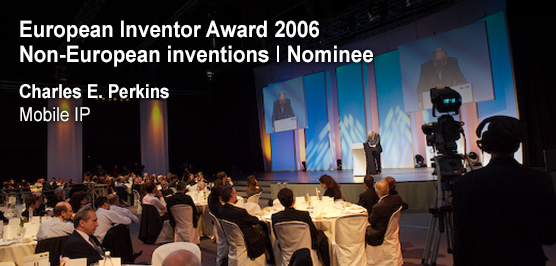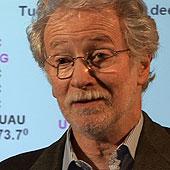Charles E. Perkins
Mobile IP
Attentive as an Office Assistant
In 1989, Charles E. Perkins and his colleagues at the IBM T.J. Watson Research Centre in Hawthorn, New York, were working on the future of the Internet. Though personal computers had become widely popular, laptops and personal digital assistants (PDAs) were still few and far between. Except at IBM.
In the computer giant’s labs, researchers developed a mobile wireless device resembling PDAs such as today’s Palm Pilot or Handspring Treo. To say they were ahead of the game would be an understatement: Palm’s and Handspring’s products wouldn’t hit the market for about another decade.
While wireless mobility was great in theory, there was one major practical problem: getting the information sent to a mobile device via the Internet when the device keeps moving. For stationary computers the problem doesn’t exist because each computer has an IP address that remains stable, allowing network routers to send emails and other information to their destinations securely.
“But when we moved from one place to another with our prototype device, all communication would break down,” said Perkins, explaining that the existing Internet routers had no way of knowing where to send the data packets without a stable IP address.
So Perkins set about to solve the problem. His invention can be described by using the analogy of an office assistant: When an executive is on a business trip, the office assistant knows where the person is and forwards mails, phone calls and faxes directly to the new address. When the executive arrives in another city, the assistant simply updates the forwarding address. There is no interruption of service, and the sender doesn’t even need to know that the addressee is actually moving about the country.
Perkins’ solution works accordingly when a mobile device moves between different networks. The communication infrastructure employs home agents, foreign agents and mobile nodes. To ensure safety for use in a corporate environment, Perkins used an encryption method, effectively blocking malicious code by mathematically verifying messages that were intended for the addressee. IBM patented the mobile IP technology in the United States in 1992 (US 5159592) and in Europe in 1996 (EP0483547).
The work on mobile IP, started by Perkins and expanded upon by other researchers at Carnegie Mellon University and Columbia University, resulted in an Internet Engineering Task Force (IETF) standard in 1996, which has been continuously upgraded since.
“Mobile IP is widely implemented in CDMA networks in the US and Asia,” said Peter McCann, Chairman of the IETF Mobility working group and researcher at Lucent Technologies. Because IBM has not used the patent widely and most of the work has become part of the IETF standard, it is hard to quantify the direct commercial impact the invention has had. There are, however, no doubts as to the innovative impact of the technology. Nextel, Motorola and Cisco, to name a few, are using mobile IP in parts of their infrastructure.
Researchers agree that the technology has potential going forward: “Mobile IP is being considered for future wireless networks,” said Vijay Devarapalli, a Senior Research Engineer at Nokia who currently works with Perkins. He added that Mobile IP is also used in some virtual private networks (VPN) on corporate campuses. While the standard is employed in a variety of applications in the United States, it is much less prevalent in Europe. Microsoft doesn’t use the mobile IP standard, but there are several Linux devices with mobile IP support on the market.
“It won’t be too long before PDAs and cell phones are going to be pretty powerful computing devices, and when they run operating systems with mobile IP support, it will have a big impact,” said Perkins.
After Perkins worked with IBM, he joined Sun Microsystems in 1997 and is now a Nokia Fellow at the Nokia research centre in Mountain View, California. Perkins, who holds a Master’s Degree in Mathematics from Columbia University, has nine patents and five pending patent applications. He won several IBM Invention Achievement Awards and a Service Award for contributions to the Internet Architectural Board.
It’s no wonder his unofficial title is “Father of Mobile IP Technology.”
Contact
European Inventor Award and Young Inventors Prize queries:
european-inventor@epo.org Subscribe to the European Inventor Award newsletterMedia-related queries:
Contact our Press team#InventorAward #YoungInventors




